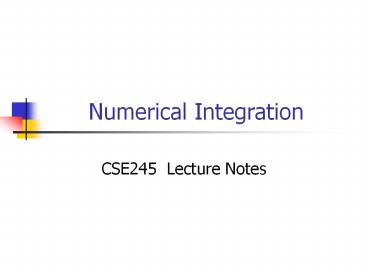Numerical Integration - PowerPoint PPT Presentation
Title:
Numerical Integration
Description:
... of the infinite Taylor series, present even with infinite-precision ... into Taylor series. ... (C/h 0) bc (-C/h 0) Solution of Linear Networks. For ... – PowerPoint PPT presentation
Number of Views:44
Avg rating:3.0/5.0
Title: Numerical Integration
1
Numerical Integration
- CSE245 Lecture Notes
2
Content
- Introduction
- Linear Multistep Formulae
- Local Error and The Order of Integration
- Time Domain Solution of Linear Networks
3
Introduction
- Transient analysis is to obtain the transient
response of the circuits. - Equations for transient analysis are usually
differential equations. - Numerical integration calculate the approximate
solutions Xn. - Linear multistep formulae are the primary
numerical integration method.
4
Linear Multistep Formulae
- Differential equations are
- X? F(X)
- Assume values Xn-1, Xn-2, , Xn-k and
derivatives X?n-1, X?n-2, , X?n-k are known,
the solution Xn and X?n can be approximated by a
polynomial of these values
5
Linear Multistep Formulae
- There are two distinct classes LMS
- Explicit predictors
- --- ?0 0
- --- Xn is the only unknown variable
- Implicit
- --- ?0 ? 0
- --- Xn, X?n are all unknown variables.
6
Linear Multistep Formulae
- Three simplest LMS formulae
- The forward Euler
- The backward Euler
- Trapezoidal
7
Linear Multistep Formulae
- The forward Euler
- Xn Xn-1 h X?n-1 0
- where ?0 1, ?1 -1, ?0 0, ?1 -1
8
Linear Multistep Formulae
- The backward Euler
- Xn Xn-1 h X?n 0
- where ?0 1, ?1 -1, ?0 -1, ?1 0
- It is an implicit representation. We may assume
some initial value for Xn and iterate to
approximate the solution Xn and X?n.
9
Linear Multistep Formulae
- Trapezoidal
- Xn Xn-1 h (X?n X?n-1 )/2 0
- where ?0 1, ?1 -1, ?0 -1/2, ?1 -1/2
- It is also an implicit representation. Xn, X?n
can be obtained through some iterative procedure.
10
Local Error
- Two crucial concepts
- Local error --- the error introduced in a single
step of the integration routine. - Global error--- the overall error caused by
repeated application of the integration formula.
11
Local Error
12
Local Error
- Two types of error in each step
- Round-off error --- due to the finite-precision
(floating-point) arithmetic. - Truncation error --- caused by truncation of the
infinite Taylor series, present even with
infinite-precision arithmetic.
13
Local Error and Order of Integration
- Local error Ek for LMS
- Ek X(tn)
- Ek can be expanded into Taylor series. If the
coefficients of the first pth derivatives are
zero, the order of integration is p.
14
Order of Integration
- Let X(t) ((tn-t)/h)l and tn tn-i ih,
- Ek
- For pth order integration, the first p1 elements
(l 0, 1, , p) will all be zeros - l 0
- l 1
- l p
15
Order of Integration
- The forward Euler
- ?0 1, ?1 -1, ?0 0, ?1 -1
- So l 0 ?0 ?1 1 (-1) 0
- l 1 ?0?0 ?1?1 - ?0 - ?1 1?0 (-1)?1 - 0
(-1) 0 - l 2 (?1?1 - 2??1)?1 ((-1)?1 - 2?(-1))?1 1
? 0 - The forward Euler is 1th order.
16
Order of Integration
- The backward Euler
- ?0 1, ?1 -1, ?0 -1, ?1 0
- So l 0 ?0 ?1 1 (-1) 0
- l 1 ?0?0 ?1?1 - ?0 - ?1 1?0 (-1)?1 -
(-1) - 0 0 - l 2 (?1?1 - 2??1)?1 ((-1)?1 - 2?0)?1 -1 ?
0 - The backward Euler is 1th order.
17
Order of Integration
- Trapezoidal
- ?0 1, ?1 -1, ?0 -1/2, ?1 -1/2
- So l 0 ?0 ?1 1 (-1) 0
- l 1 ?0?0 ?1?1 - ?0 - ?1 1?0 (-1)?1 -
(-1/2) (-1/2) 0 - l 2 (?1?1 - 2??1)?1 ((-1)?1 - 2?(-1/2))?1
0 - l 3 (?1?1 - 3??1)?12 ((-1)?1 - 3?(-1/2))?1
1/2 ? 0 - The trapezoidal method is 2th order
18
Order of Integration
- The algorithm for defining ? and ?
- --- Choose p, the order of the numerical
integration method needed - --- Choose k, the number of previous values
needed - --- Write down the (p1) equations of pth order
accuracy - --- Choose other (2k-p) constrains of the
coefficients ? and ? - --- Combine and solve above (2k1) equations
- --- Get the result coefficients ? and ?.
19
Solution of Linear Networks
- Combine the differential equations for linear
networks and the numerical integration equations - MX? -GX Pu
(1)
(2)
20
Solution of Linear Networks
- (1) ? Xn h?0X?n
- ? Xn h?0X?n b 0
- ? X?n (-1/h?0)( Xn b)
- (2)(3)? M(-1/h?0)( Xn b) -GXn Pu
- ? (-1/h?0) Xn -GXn Pu (M/h?0)b
(3)
21
Solution of Linear Networks
- For capacitance
- C v?c ic
- ? C (-1/h?0)( vc bc) ic
- ? (-C/h?0) vc (C/h?0) bc ic
22
Solution of Linear Networks
- For inductance
- L i?l vl
- ? L (-1/h?0)( il bl) vl
- ? (-L/h?0) il (L/h?0) bl vl
23
References
- CK. Cheng, John Lillis, Shen Lin and Norman Chang
- Interconnect Analysis and Synthesis, Wiley and
Sons, 2000 - Jiri Vlach and Kishore Singhal
- Computer Methods for Circuit Analysis and
Design, 1983































